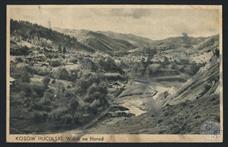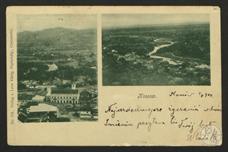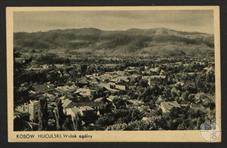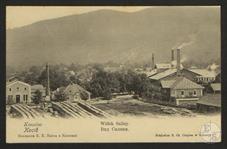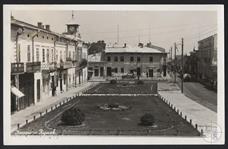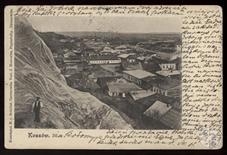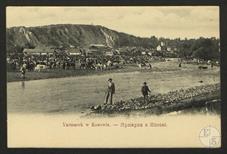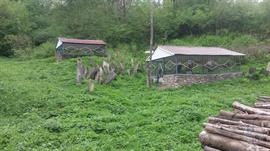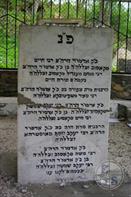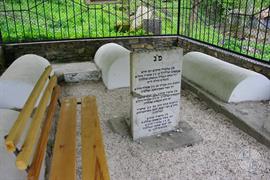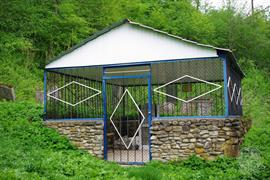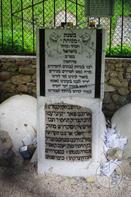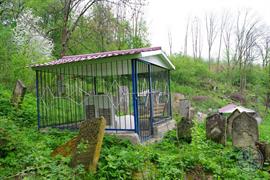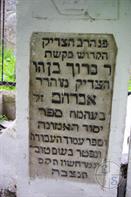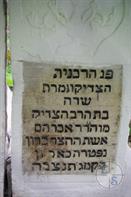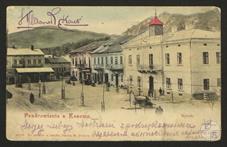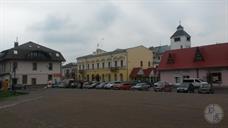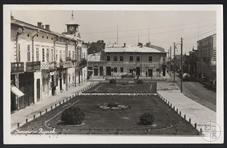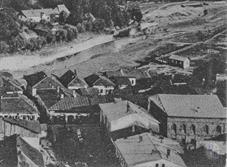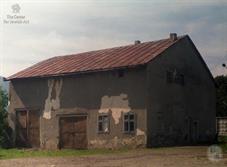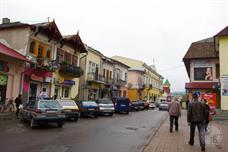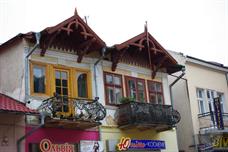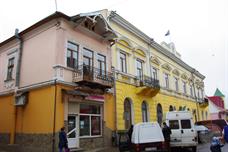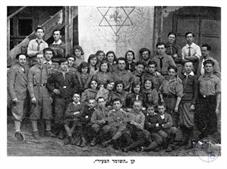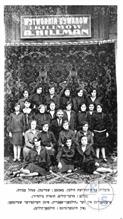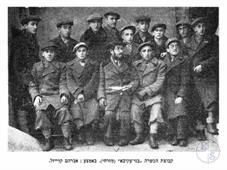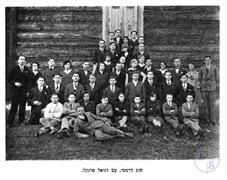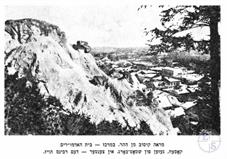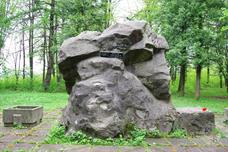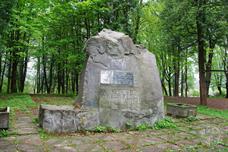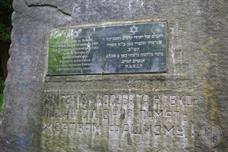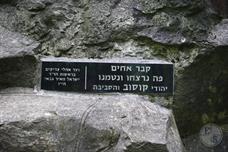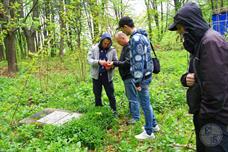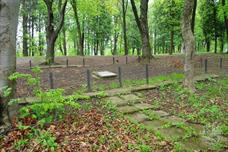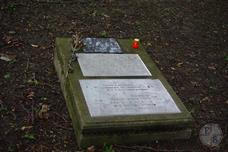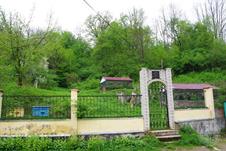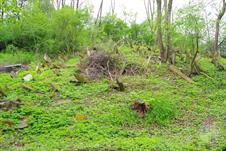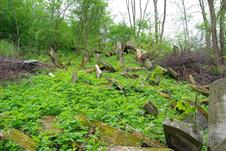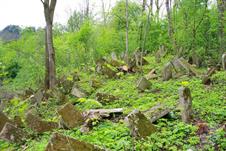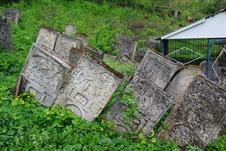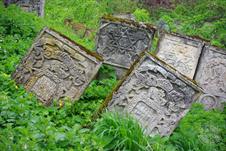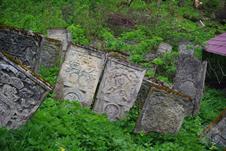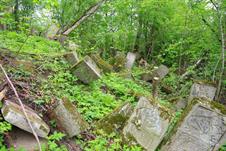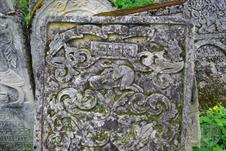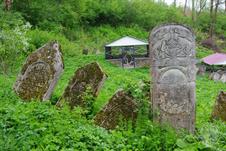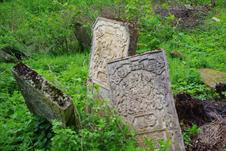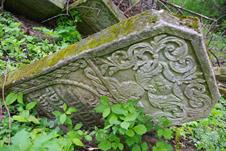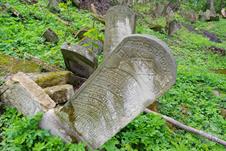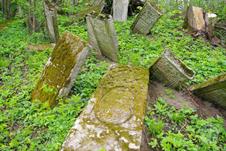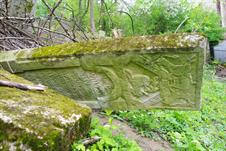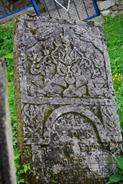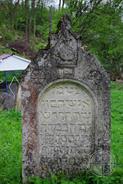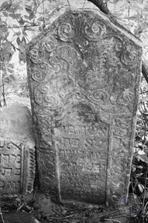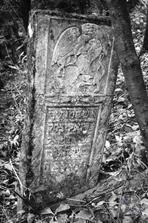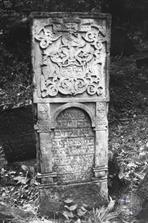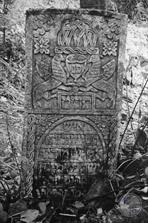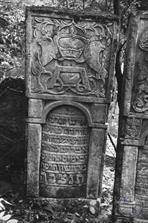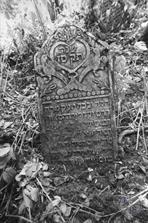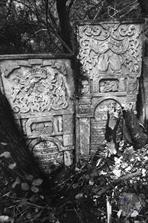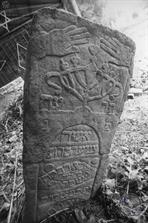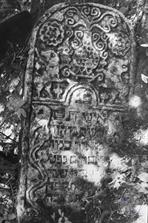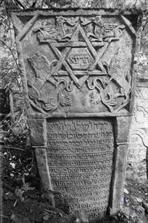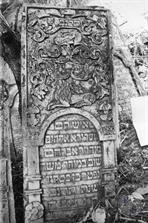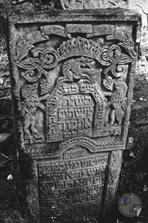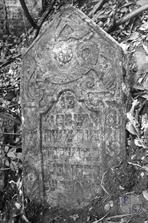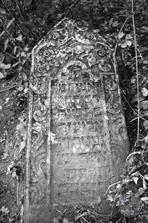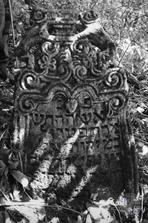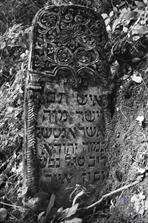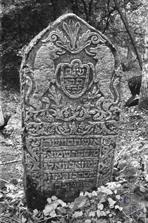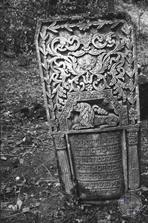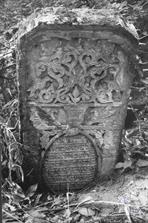Kosiv
Sources:
- Pinkas Hakehillot Polin: Encyclopedia of Jewish Communities, Poland, Volume II, published by Yad Vashem, Jerusalem. Kosow
- Shtetl Routes. Kosiv
- Electronic Jewish encyclopedia
- Jewish encyclopedia of Brockhaus & Efron
- Ilya Altman. Holocaust on the territory of the USSR. Encyclopedia.
Photo:
- Eugene Shnaider
- Michael Kheifetz, Ukrzakhidprojectrestavratsiia: Center for Jewish art. Kosiv
- Biblioteka Narodowa Polona. Kosow
- Pinkas Hakehillot Polin: Encyclopedia of Jewish Communities, Poland, Volume II, published by Yad Vashem, Jerusalem. Kosow
- Shtetl Routes. Kosiv
- Electronic Jewish encyclopedia
- Jewish encyclopedia of Brockhaus & Efron
- Ilya Altman. Holocaust on the territory of the USSR. Encyclopedia.
Photo:
- Eugene Shnaider
- Michael Kheifetz, Ukrzakhidprojectrestavratsiia: Center for Jewish art. Kosiv
- Biblioteka Narodowa Polona. Kosow
Ivano-Frankivsk region
The settlement in the Hutsulshchina, which was part of the territory of the recently formed Commonwealth, arose in the 16th century. This happened after salt deposits were discovered in the Sniatyn district and a salt bath were founded, where this product was dumped.
Salt at all times was a valuable resource, and the bathhouse has become the subject of a dispute between the noble Polish genera of the Genchinsky and Yazlovetsky. In 1560, the Sniatyn headman Genchinsky built a town called Rykov around a profitable enterprise. But immediately after the death of Genchinsky, his competitor Yuri Yazlovetsky armed his servants and employees, attacked Rykov and completely destroyed him. The bathhouse went into the property of the Yazlovetsky.
In 1579, the town was rebuilt again, and received the name "Kosov" (ukr. Kosiv, Косів). In the tax register of this year, Kosov is listed as a place belonging to Mikhaylo Yazlovetsky, the son of the warlike Yuri. The place became the center of a separate private - ownership volost.
Nevertheless, the change of name did not make it more successful. Kosov was destroyed by the Turks and Tatars twice more, in 1621 and 1624. For resuscitation of the city, its owners acted as a verified way - they invited Jews for living.
Salt at all times was a valuable resource, and the bathhouse has become the subject of a dispute between the noble Polish genera of the Genchinsky and Yazlovetsky. In 1560, the Sniatyn headman Genchinsky built a town called Rykov around a profitable enterprise. But immediately after the death of Genchinsky, his competitor Yuri Yazlovetsky armed his servants and employees, attacked Rykov and completely destroyed him. The bathhouse went into the property of the Yazlovetsky.
In 1579, the town was rebuilt again, and received the name "Kosov" (ukr. Kosiv, Косів). In the tax register of this year, Kosov is listed as a place belonging to Mikhaylo Yazlovetsky, the son of the warlike Yuri. The place became the center of a separate private - ownership volost.
Nevertheless, the change of name did not make it more successful. Kosov was destroyed by the Turks and Tatars twice more, in 1621 and 1624. For resuscitation of the city, its owners acted as a verified way - they invited Jews for living.
Jews received some privileges and began to actively populate the town. As of 1764, 343 Jewish families were listed in the Kosiv volost. Probably, some Jews lived on these lands earlier, but there was no independent community. Only in the 18th century, the Jewish cemetery was founded in Kosiv and the first wooden synagogue was built.
Jews populated, as in all the shtetls, mainly central streets adjacent to the city square. Soon, all trade, rental of land, drinking institutions, mills and other enterprises, including the saltworks, concentrated in their hands.
The rapidly rich city attracted the "folk avengers" - Opryshky, and they often visited here. During one of these “visits”, took place acquaintance Baal Shem Tov with the legendary leader of the opryshks Oleksa Dovbush. Many writers described in their works the meetings of Besht and Dovbush, for example, Shmuel Agnon. Different legends always converged in one - relations between the tsadik and the robber were comradely. Rabbi Isroel somehow helped Oleksa hide from the persecution, and the Ukrainian “Robin Hood” gave the tsadik a smoking tube, with which Besht did not part until the end of his life.
Jews populated, as in all the shtetls, mainly central streets adjacent to the city square. Soon, all trade, rental of land, drinking institutions, mills and other enterprises, including the saltworks, concentrated in their hands.
The rapidly rich city attracted the "folk avengers" - Opryshky, and they often visited here. During one of these “visits”, took place acquaintance Baal Shem Tov with the legendary leader of the opryshks Oleksa Dovbush. Many writers described in their works the meetings of Besht and Dovbush, for example, Shmuel Agnon. Different legends always converged in one - relations between the tsadik and the robber were comradely. Rabbi Isroel somehow helped Oleksa hide from the persecution, and the Ukrainian “Robin Hood” gave the tsadik a smoking tube, with which Besht did not part until the end of his life.
Since 1772, Kosiv as part of the Austrian Empire. The changes was not very sensitive to the Jewish community, it continued to develop.
In the formation of religious views, the influence of Besht was significant, which is understandable. In Kosiv there lived a contemporary of Baal Shem Rabbi Nakhman, whose teaching was largely close to the teachings of Besht, but at the same time there were serious contradictions between them.
The successor of Nahman, Rabbi Borukh Ben Abraham, was also very popular. But after him, Kosiv’s rabbi is a follower of Besht, Rabbi Menachem Mendel, the son of Jacob Kopl Ben Nehamia, “Hasid from Kolomyia”, who was khazan in the synagogue of Besht.
Menachem Mendel founds the Hasidic court in the town and becomes the founder of Kosiv Hasidism. His most famous branch was Vizhnitsa Hasidism, in whose teaching the grandson and namesake of the Kosiv rabbi Menachem Mendel Hager developed the ideas of his grandfather.
After the death of Menachem Mendel from Kosiv, his descendants were the rabbis of the town until 1942.
In 1847, part of the Hasids left Kosiv to Eretz Isroel, where they built their synagogue in the city of Tsfat.
The Kosiv Hasids belonged to most large synagogue, built at the expense of the entrepreneur from Zabolotov Nathan Bander.
In the formation of religious views, the influence of Besht was significant, which is understandable. In Kosiv there lived a contemporary of Baal Shem Rabbi Nakhman, whose teaching was largely close to the teachings of Besht, but at the same time there were serious contradictions between them.
The successor of Nahman, Rabbi Borukh Ben Abraham, was also very popular. But after him, Kosiv’s rabbi is a follower of Besht, Rabbi Menachem Mendel, the son of Jacob Kopl Ben Nehamia, “Hasid from Kolomyia”, who was khazan in the synagogue of Besht.
Menachem Mendel founds the Hasidic court in the town and becomes the founder of Kosiv Hasidism. His most famous branch was Vizhnitsa Hasidism, in whose teaching the grandson and namesake of the Kosiv rabbi Menachem Mendel Hager developed the ideas of his grandfather.
After the death of Menachem Mendel from Kosiv, his descendants were the rabbis of the town until 1942.
In 1847, part of the Hasids left Kosiv to Eretz Isroel, where they built their synagogue in the city of Tsfat.
The Kosiv Hasids belonged to most large synagogue, built at the expense of the entrepreneur from Zabolotov Nathan Bander.
Since 1867, the town has become the center of Kosio Powiat.
In 1898, a craft school was opened at the expense of the Baron Maurice de Girsch fund in Kosiv.
In 1909, the organization Agidat Zion founded the Safa Brura school with teaching in Hebrew.
At the beginning of the 20th century, 2560 Jews lived in Kosiv, which amounted to 82.5% of the total population. Jews owned a variety of workshops and shops, before the First World War they owned 40 houses in the central part of Kosiv.
In 1898, a craft school was opened at the expense of the Baron Maurice de Girsch fund in Kosiv.
In 1909, the organization Agidat Zion founded the Safa Brura school with teaching in Hebrew.
At the beginning of the 20th century, 2560 Jews lived in Kosiv, which amounted to 82.5% of the total population. Jews owned a variety of workshops and shops, before the First World War they owned 40 houses in the central part of Kosiv.
Soon the calm life of the town ended. In 1914 - 1917, Kosiv was twice occupied by the Russian army, which was invariably accompanied by the robberies of Jewish shops.
After the collapse of Austria-Hungary in November 1918, the power of the West-Ukrainian People’s Republic was proclaimed in the city. She lasted less than a year, already in May 1919, the Romanian troops occupied the Romanian troops. But they delayed for only 3 months. Since August 1919, Kosov has been a powiat center of the Stanislav Voivodeship as part of Poland.
All these cataclysms greatly influenced the number of Jewish community, its growth began to decline markedly. In 1921, 2166 Jews were already only 51% of the total population.
Subsequently, the percentage of Jews decreased even more, since in 1929 the village of Old Kosiv and Verbovets, who were primarily inhabited by Ukrainians, were attached to Kosiv, and after another 5 years - the village of Moskalivka. Nevertheless, in 1928, the Jews made half of the composition of the Kosiv municipal council, and from 1929 to 1934 the mayor’s duty was also performed by a Jew, Dr. Yakov Gertner.
After the collapse of Austria-Hungary in November 1918, the power of the West-Ukrainian People’s Republic was proclaimed in the city. She lasted less than a year, already in May 1919, the Romanian troops occupied the Romanian troops. But they delayed for only 3 months. Since August 1919, Kosov has been a powiat center of the Stanislav Voivodeship as part of Poland.
All these cataclysms greatly influenced the number of Jewish community, its growth began to decline markedly. In 1921, 2166 Jews were already only 51% of the total population.
Subsequently, the percentage of Jews decreased even more, since in 1929 the village of Old Kosiv and Verbovets, who were primarily inhabited by Ukrainians, were attached to Kosiv, and after another 5 years - the village of Moskalivka. Nevertheless, in 1928, the Jews made half of the composition of the Kosiv municipal council, and from 1929 to 1934 the mayor’s duty was also performed by a Jew, Dr. Yakov Gertner.
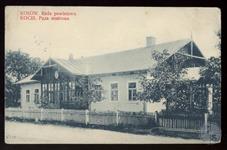 |
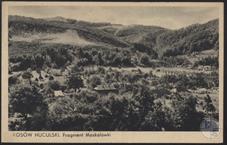 |
 |
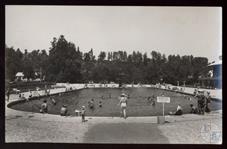 |
| Municipality | Moskalivka, which became one of the parts of Kosiv | Under Poland, Kosiv becomes a resort city |
Salt production, which laid the foundation for the city, gradually faded away, although finally salvarni closed only in 1938. Even in the Austrian period, Kosiv becomes a famous center for the production of fabrics and carpets - and remains so to this day. The workshop of carpets “Hutsul art”, belonging to the true Gutsul named Gilman, worked in the town. Also there were knitted factories of Jews Schnieberg and Gund. In 1928, about 40 Jewish masters united in a carpet artel, which lasted until 1941.
In addition to the fabric, many other enterprises belonged to Jews, and even a Jewish cooperative bank was opened. Along with traditional communal institutions, various political parties operated, the Zionist organizations “Poalei Zion” and “Mizrahi”, the youth movements “Ha-shomer Ga-Tsair” and “Ga-Noar Ga-G.” were active.
The tone of cultural life was set by the "Merkaz Rukhani" society and the Makkabi sports club. In 1934 - 1936, a newspaper was published for Yiddish "Kosover Shtime" ("Voice of Kosiv").
Together with the Poles, anti -Semitism also came to Kosiv. The Polish National Democratic Party called on the local population for the boycott of Jewish stores and goods. For many, these calls found a response. By the end of the 1930s, the number of Jewish shops significantly decreased in the town, and the percentage of Jewish poor people increased.
In addition to the fabric, many other enterprises belonged to Jews, and even a Jewish cooperative bank was opened. Along with traditional communal institutions, various political parties operated, the Zionist organizations “Poalei Zion” and “Mizrahi”, the youth movements “Ha-shomer Ga-Tsair” and “Ga-Noar Ga-G.” were active.
The tone of cultural life was set by the "Merkaz Rukhani" society and the Makkabi sports club. In 1934 - 1936, a newspaper was published for Yiddish "Kosover Shtime" ("Voice of Kosiv").
Together with the Poles, anti -Semitism also came to Kosiv. The Polish National Democratic Party called on the local population for the boycott of Jewish stores and goods. For many, these calls found a response. By the end of the 1930s, the number of Jewish shops significantly decreased in the town, and the percentage of Jewish poor people increased.
On September 22, 1939, Soviet power was established in Kosiv, and the Jewish communal life was completely destroyed. The synagogue was closed, all political parties were prohibited, private enterprises were nationalized.
In July 1941, Kosiv was occupied by Hungarian troops. At this point, the Jewish population of the city increased due to refugees from Western Poland and Karpatian Rus' to 4 thousand people. Judenrat was created, who opened the dining room and assisted those in need.
In September, the power in Kosiv passed to the German administration.
In early October, the Germans burned the synagogue and killed 7 Jews trying to find shelter in her.
On October 16 and 17, 2200 Jews were taken to the castle mountain above the Moskalivka bridge and shot.
In July 1941, Kosiv was occupied by Hungarian troops. At this point, the Jewish population of the city increased due to refugees from Western Poland and Karpatian Rus' to 4 thousand people. Judenrat was created, who opened the dining room and assisted those in need.
In September, the power in Kosiv passed to the German administration.
In early October, the Germans burned the synagogue and killed 7 Jews trying to find shelter in her.
On October 16 and 17, 2200 Jews were taken to the castle mountain above the Moskalivka bridge and shot.
On April 24, 1942, 600 Jews from Kosiv were sent to the ghetto of Kolomyia, and from there they were deported to the Belzhets destruction camp. The remaining Jews were moved to the ghetto.
On September 7 and 28, two “actions” of destruction were carried out; the survivors were sent to Kolomyia.
After the war, several Jews returned to the Kosiv, but they did not stay here for a long time. In the preserved house of Kosiv rabbi, 2 museums now operate, including the UPA museum. And in the old cemetery, many beautiful tombstones has been preserved.
On September 7 and 28, two “actions” of destruction were carried out; the survivors were sent to Kolomyia.
After the war, several Jews returned to the Kosiv, but they did not stay here for a long time. In the preserved house of Kosiv rabbi, 2 museums now operate, including the UPA museum. And in the old cemetery, many beautiful tombstones has been preserved.

- Home
- Shtetls
- Vinnytsia region
- Volyn region
- Dnipro region
- Donetsk region
- Zhytomyr region
- Zakarpattia region
- Zaporizhzhia region
- Ivano-Frankivsk region
- Kyiv region
- Kropyvnytskyi region
- Luhansk region
- Lviv region
- Mykolayiv region
- Odessa region
- Poltava region
- Rivne region
- Sumy region
- Ternopil region
- Kharkiv region
- Kherson region
- Khmelnytskyi region
- Chernihiv region
- Chernivtsi region
- Cherkasy region
- Crimea
- Synagogues
- Cemeteries
- Objects & guides
- Old photos
- History
- Contact
Jewish towns of Ukraine
Jewish towns of Ukraine
My shtetl
My shtetl
Donate
